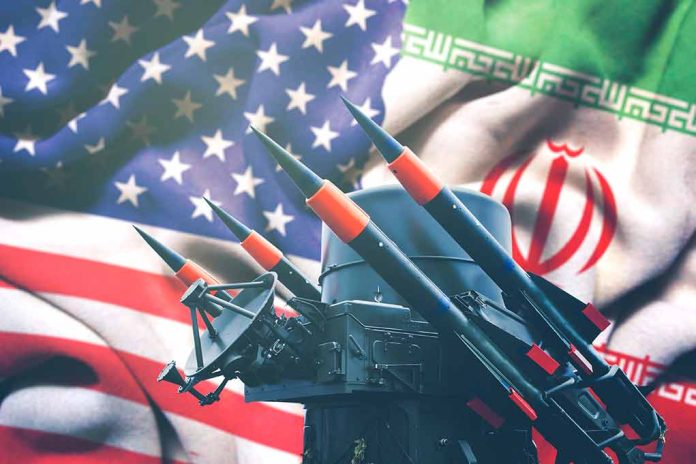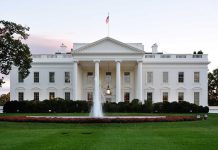
President Trump launches unprecedented attack on three Iranian nuclear sites, declares “HISTORIC MOMENT” as B-2 stealth bombers deliver massive bunker-busting bombs deep inside Iranian territory.
Key Takeaways
- The U.S. has struck three Iranian nuclear facilities: Fordow, Natanz, and Esfahan, with “a full payload of bombs” dropped on the heavily fortified Fordow site buried 300 feet beneath a mountain.
- This marks the first direct U.S. military involvement in the Israel-Iran conflict, despite Trump’s previous promises to avoid new Middle East conflicts.
- The strikes utilized the GBU-57 Massive Ordnance Penetrator (MOP), a 30,000-pound bunker-buster bomb deemed necessary to destroy Iran’s fortified nuclear infrastructure.
- All American aircraft have safely exited Iranian airspace following the mission, with Trump scheduled to address the nation about this dramatic escalation.
- Iran has previously vowed to retaliate against any U.S. involvement, raising concerns about potential attacks on American troops and installations in the region.
America’s Massive Bunker-Busting Operation
The United States has executed a coordinated attack on Iran’s nuclear infrastructure, targeting three key facilities with advanced weaponry designed to penetrate deeply fortified sites. The primary target, Fordow, is a uranium enrichment facility buried 300 feet beneath a mountain with substantial air defenses, making it virtually impenetrable to conventional weapons. President Trump confirmed the operation’s success in a statement saying U.S. B-2 stealth bombers delivered a “full payload of BOMBS” to the Fordow site, while also striking facilities at Natanz and Esfahan. These three locations represent the backbone of Iran’s nuclear program.
Military analysts have long maintained that only America’s GBU-57 Massive Ordnance Penetrator (MOP) – a specialized 30,000-pound bunker-buster bomb – had the capability to destroy Fordow’s underground infrastructure. The operation involved B-2 Spirit bombers that departed from Whiteman Air Force Base in Missouri with aerial refueling support observed en route. The Pentagon had determined that Israel’s military capabilities alone were insufficient to neutralize such heavily fortified targets, particularly Fordow, which led to America’s direct involvement following days of Israeli strikes on Iranian air defenses and missile capabilities.
Trump’s Decision and Diplomatic Failure
President Trump’s decision to launch strikes represents a significant shift in his stance toward Iran and military interventions. Despite campaigning on promises to avoid new Middle East conflicts, Trump determined that diplomatic channels with Iran had been exhausted. The administration had initially sought a new nuclear agreement after abandoning the Obama-era deal in 2018, but recent developments – including Iran’s advancing nuclear program and escalating regional tensions – prompted a more aggressive approach. Trump even attempted a last-ditch diplomatic effort that reportedly failed due to communication issues with Iran’s Supreme Leader.
“We have completed our very successful attack on the three Nuclear sites in Iran, including Fordow, Natanz, and Esfahan. All planes are now outside of Iran air space. A full payload of BOMBS was dropped on the primary site, Fordow. All planes are safely on their way home,” stated President Trump.
In recent days, Trump had taken an increasingly hardline stance, calling for Iran’s “UNCONDITIONAL SURRENDER” and claiming U.S. control over Iranian airspace. He even issued direct threats to Ayatollah Ali Khamenei, stating that his location had been identified. After the successful strikes, Trump characterized the operation as “an HISTORIC MOMENT FOR THE UNITED STATES OF AMERICA, ISRAEL, AND THE WORLD,” adding that “IRAN MUST NOW AGREE TO END THIS WAR.”
Regional Consequences and Security Implications
The American strikes mark a historic escalation in the Middle East conflict that began with Israeli operations against Iranian targets over a week ago. While Israel had been conducting attacks aimed at degrading Iran’s air defenses and missile capabilities, the U.S. intervention specifically targeted nuclear infrastructure – signaling a clear determination to prevent Iran from developing nuclear weapons. This coordinated approach represents the most significant military action against Iran’s nuclear program in history, far exceeding previous covert operations and cyberattacks that had merely delayed progress.
“This is an HISTORIC MOMENT FOR THE UNITED STATES OF AMERICA, ISTAEL (sic), AND THE WORLD. IRAN MUST NOW AGREE TO END THIS WAR. THANK YOU!” stated President Trump.
Iran has repeatedly vowed to retaliate against any American involvement in attacks on its territory, raising serious concerns about potential strikes on U.S. troops and military installations throughout the Middle East. The Pentagon has reportedly been enhancing defensive measures at American bases in the region while repositioning naval assets to protect against possible Iranian counterattacks. As this situation develops, regional stability hangs in the balance, with American allies bracing for potential repercussions. The question now becomes whether this decisive action will achieve its intended purpose of permanently derailing Iran’s nuclear ambitions or further inflame a volatile region.








